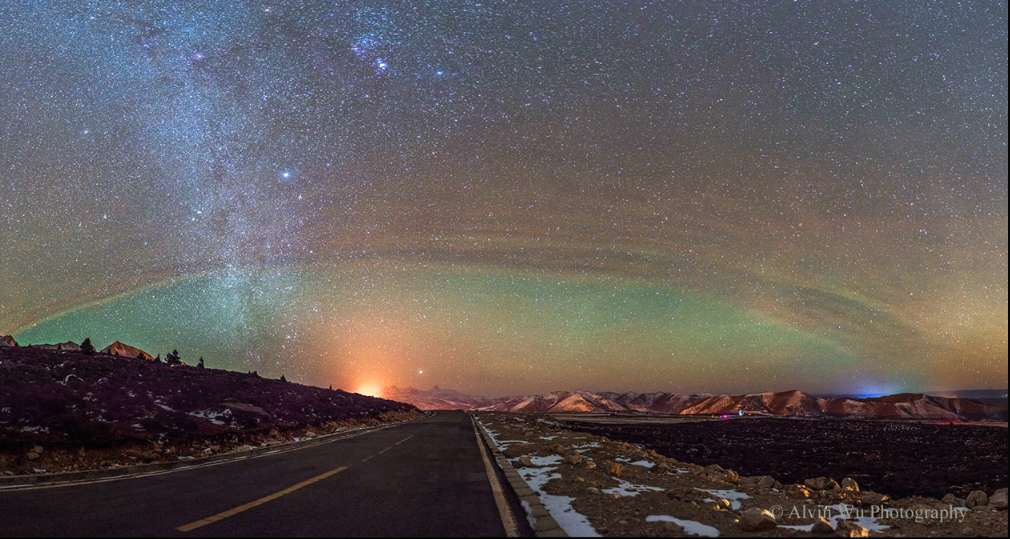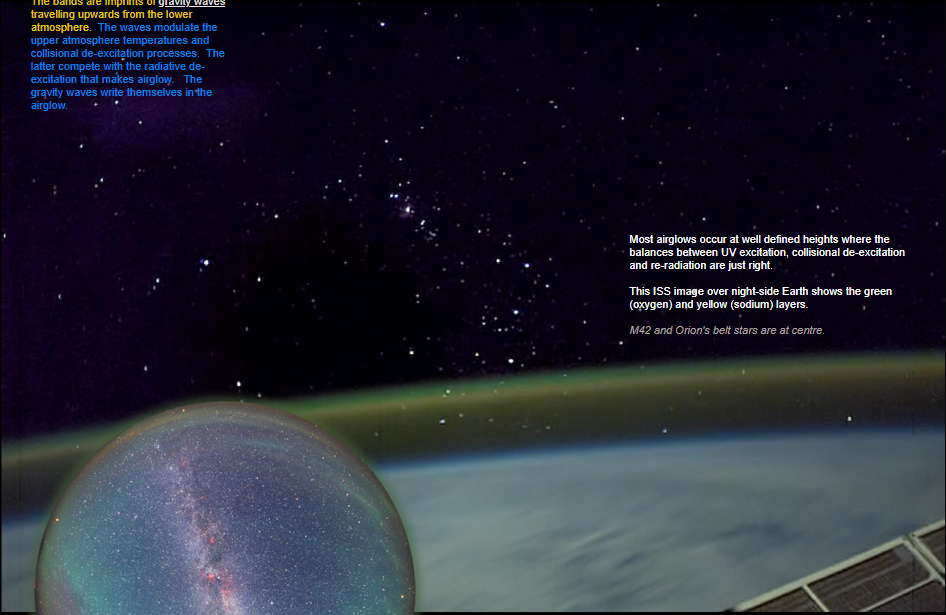Unusual Airglow, Zheduo Mountain, China- OPOD
Unusual Airglow over Zheduo Mountain, China: A Spectacular Natural Phenomenon
Airglow, a fascinating atmospheric phenomenon, creates a mesmerizing display of colors in the night sky. When the sun's extreme ultraviolet rays reach Earth's thermosphere, they interact with oxygen atoms and nitrogen molecules, causing them to become excited. As these excited particles collide with other components of the atmosphere, they slowly release their energy through radiation, giving rise to airglow.
The most common form of airglow is the vibrant green glow emitted by oxygen atoms. However, airglow can also manifest in other hues, such as red from oxygen and OH radicals, yellow from sodium, and even blue from oxygen. Each color offers a unique spectacle that adds to the enchantment of the night sky.
In the case of Alvin Wu's photograph capturing the airglow over Zheduo Mountain in China, its extraordinary feature lies in its strong and well-defined structure. The image reveals a near continuous zone of intense green oxygen glow, flanked by bands of yellow and red. These bands are evidence of gravity waves that propagate upwards from the lower atmosphere.
Gravity waves influence the temperature and collisional de-excitation processes in the upper atmosphere, competing with the radiative de-excitation responsible for airglow. As a result, these gravity waves leave their imprints on the airglow, creating intricate patterns and enhancing its visual appeal.
Typically, airglows occur at specific altitudes where the delicate balance between UV excitation, collisional de-excitation, and re-radiation is just right. This equilibrium allows for the optimal conditions necessary for airglow to manifest. The International Space Station (ISS) has captured remarkable images showcasing these distinct layers of airglow on Earth's night side. The green layer, primarily composed of oxygen atoms, and the yellow layer, caused by sodium, create a stunning display against the backdrop of celestial objects such as the M42 and Orion's belt stars.
The phenomenon of airglow continues to captivate scientists and sky enthusiasts alike. Its intricate interplay of atmospheric processes and the mesmerizing colors it produces make it a subject of ongoing research. By studying airglow, scientists gain valuable insights into the dynamics of Earth's upper atmosphere and the complex interactions between different atmospheric components.
While airglow is a natural occurrence, it can also be influenced by human activities. Light pollution, for example, can interfere with the visibility and intensity of airglow. Therefore, it is essential to raise awareness about the importance of preserving dark skies to fully appreciate and study this awe-inspiring phenomenon.
In conclusion, the unusual airglow over Zheduo Mountain in China captured by Alvin Wu showcases the stunning beauty and complexity of this atmospheric phenomenon. The distinct structure, created by gravity waves, adds a unique touch to the vibrant colors of airglow. As we continue to explore and understand airglow, we deepen our knowledge of Earth's atmosphere and gain a greater appreciation for the wonders that unfold above us each night.

Unusual airglow over Zheduo Mountain, China ~ An image by Alvin Wu (Flickr). Image ©Alvin Wu, shown with permission

The sun’s extreme ultraviolet shines on Earth’s thermosphere. It is (thankfully for us) absorbed and produces excited oxygen atoms and nitrogen molecules. These collide and excite other atmosphere components that slowly lose their energy by radiating into the night – airglow.
Green airglow from oxygen atoms is the most common. Reds from oxygen and OH radicals are also seen as are yellow sodium and even blue oxygen airglows.
Alvin Wu’s airglow is remarkable for its strong structure. There is a near continuous zone of green oxygen glow bordered by yellow and red bands.
The bands are imprints of gravity waves travelling upwards from the lower atmosphere. The waves modulate the upper atmosphere temperatures and collisional de-excitation processes. The latter compete with the radiative de-excitation that makes airglow. The gravity waves write themselves in the airglow.

Most airglows occur at well defined heights where the balances between UV excitation, collisional de-excitation and re-radiation are just right.
This ISS image over night-side Earth shows the green (oxygen) and yellow (sodium) layers.
M42 and Orion's belt stars are at centre.
Note: this article has been automatically converted from the old site and may not appear as intended. You can find the original article here.
Reference Atmospheric Optics
If you use any of the definitions, information, or data presented on Atmospheric Optics, please copy the link or reference below to properly credit us as the reference source. Thank you!
-
<a href="https://atoptics.co.uk/blog/unusual-airglow-zheduo-mountain-china-opod/">Unusual Airglow, Zheduo Mountain, China- OPOD</a>
-
"Unusual Airglow, Zheduo Mountain, China- OPOD". Atmospheric Optics. Accessed on April 20, 2024. https://atoptics.co.uk/blog/unusual-airglow-zheduo-mountain-china-opod/.
-
"Unusual Airglow, Zheduo Mountain, China- OPOD". Atmospheric Optics, https://atoptics.co.uk/blog/unusual-airglow-zheduo-mountain-china-opod/. Accessed 20 April, 2024
-
Unusual Airglow, Zheduo Mountain, China- OPOD. Atmospheric Optics. Retrieved from https://atoptics.co.uk/blog/unusual-airglow-zheduo-mountain-china-opod/.